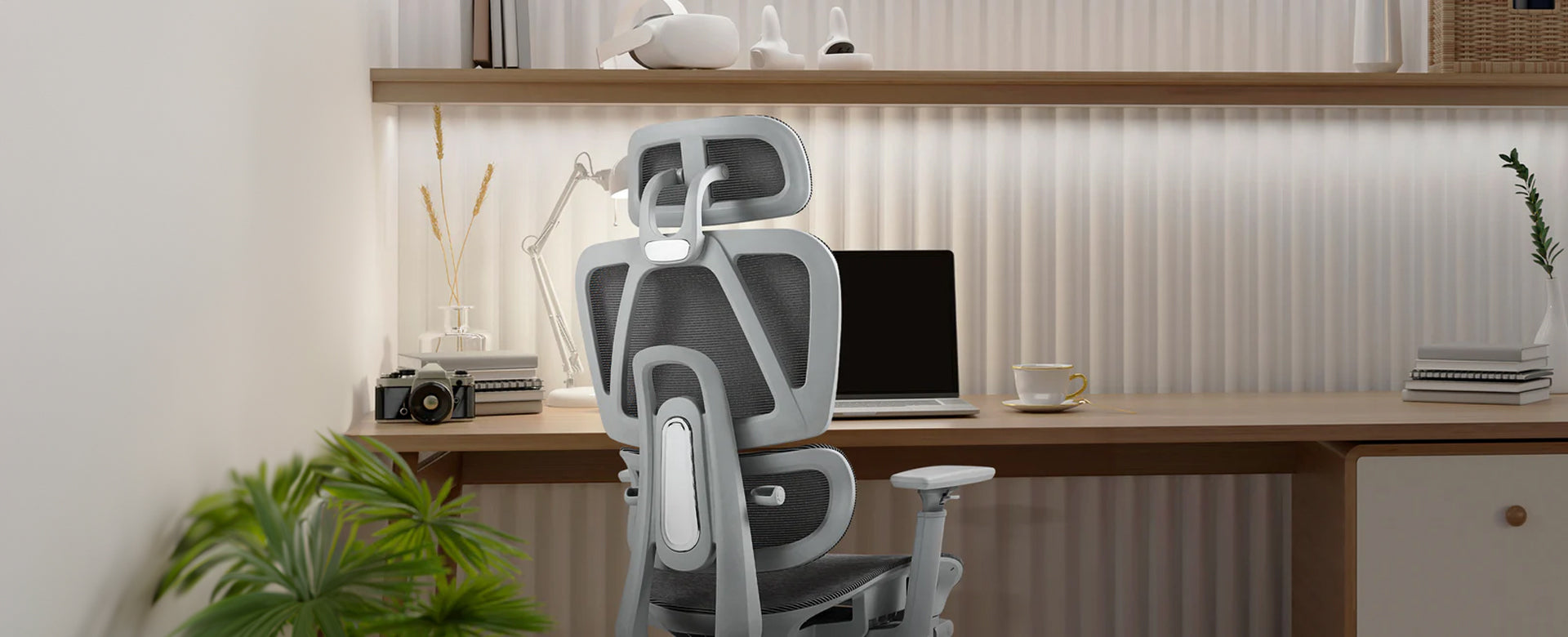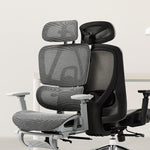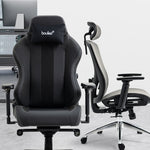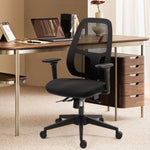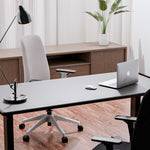Table of Contents
Do you know about office chair butt?
Do you often feel discomfort in your waist, hips, or legs when you are at work? The main reason is that you sit for a long time to work. This problem is often ignored by us, but it often happens around us. In the field of office ergonomics, we need to pay more attention to our health, so how does office chair butt happen and how should it be solved? Please follow our article so we can answer you one by one.
What Is Office Chair Butt?
"Office Chair Butt" is a colloquial term that refers to the phenomenon that sitting on an office chair for a long time causes discomfort in the hips and even pain. This is not a formal medical diagnosis, but it is a common problem in an office environment.
The main symptoms are:
- Numbness or tingling: Numbness or tingling in the hips or legs is mainly caused by long-term sitting stimulating the nerves in the hips and legs.
- Muscle soreness: Because the hips are under pressure for a long time, there will be some soreness in the waist, legs and hips, especially when you sit on an ergonomic chair.
- Muscle weakness: This is the most serious symptom. Prolonged discomfort may lead to atrophy of the buttocks and surrounding muscles.

What Does Office Chair Butt Look Like
Your butt starts to look like the seat of a chair. This is what is called "office chair butt". Muscle weakness is the most obvious symptom and shape.
Sitting for a long time causes changes in your body. The buttocks tend to look flatter and less rounded. The buttocks muscles will sag and become too loose. These are no different from any muscle in your body that becomes deformed when it is not used frequently. For example, if your upper arms are affected by excessive force, they will also form so-called sagging.
Office chair butt is mainly manifested by:
- Soft buttocks: long-term lack of activity, muscles are replaced by fat tissue.
- Sagging: loss of muscle support, and the deposition of fat tissue when the muscles are inactive.
- Flat: long-term inactivity makes the buttocks muscles lose tension and look flatter.
-
Growth Deformity: Excessive arching of the lower back or forward tilting of the buttocks.
Office Chair Butt Happen Reason
1. Office Desks and Chairs Poor Ergonomics
One of the main reasons why office chair butt occurs is because of a wrong set of desks and chairs. Wrong desks and chairs are not ergonomic, lack the necessary functions, and cannot provide enough support points for the body. Poor ergonomic design defects include:

Poor Office Chair Cushions
When the cushions of an office chair are overfilled and too soft, your hips and thighs will experience greater friction with the chair, bearing more weight than other parts, which can cause numbness and tingling over time. On the contrary, if the cushions are not filled enough, it will make your coccyx protrude and directly bear the pressure.
Poor quality office chair products have a flatter design of the cushions, which not only cannot fit your body curves and relieve the pressure on your back and hips, but also cause your weight to be unevenly distributed when you sit in the chair, causing discomfort.
Poor office chair cushion material often uses rebonded foam, which will cause heat accumulation in your waist and hips during use, further increasing the pressure on your thighs and hips.
Ergonomic office chair cushions are made of 100% cold-cure foam, although cold-cure foam is expensive and needs to be moulded in one piece. But compared with rebonded foam, cold-cure foam has significantly higher density and resilience, and is also more durable. Boulies office chair cushion uses 100% Cold-cure foam, which is committed to your comfort and health.
Unsuitable Desk and Chairs, Lack of Lumbar Support
An inappropriate chair cannot maintain an effective support point for the back. Meanwhile, an inappropriate desk height will cause pulling of the arms and back, and the pain in the back will extend to the buttocks.
Poor Desks and Chairs, Lack of Adjustability
Different heights, different lengths of legs and arms make everyone's body unique, and when sitting, it needs to be adjusted according to specific circumstances.
However, desks and chairs with limited adjustment cannot accommodate the diverse sitting postures and body shapes of different individuals, leading to poor sitting posture and uneven body force distribution. Long-term use will only increase your body pain. A good chair will adapt to your body and make you feel comfortable.
Of course, all Boulies office chairs and desks can be adjusted according to your body which provides a comfortable and supportive sitting area.

2. Improper Selection of Chair and Desk Size
Perhaps you will wonder why you still get office chair butt problems when you are already sitting on an ergonomic desk and chair. When choosing office desks and chairs, we tend to pay more attention to the size that fits the office scene, and often ignore the ergonomic desk and chair size that fits our height. Your office chair butt pain is related to the size of the office desk and chair.
The impact of inappropriate table and chair sizes on the user's body:
- The office chair is too high, the armrests are too low, and the seat depth is too deep. This causes your body to lean forward and bend over, increasing pressure below the knee (popliteal fossa).
- The office chair is too low, the armrests are too high, and the seat depth is too low. This causes the head to tilt upward, increasing pressure on the coccyx and lower back.
- The table is too high, and the head tilts upward. In this case, your cervical spine is under great pressure, and blood circulation is poor.
- If the table is too low, you will hunch over and cannot form a correct posture, increasing pressure on your back.
Related Articles:
Standard Desk Dimensions for Office & Home
How to Find the Ideal Height for Your Office Chair
3. Prolonged Sitting
Sitting for long periods of time can affect your health. One long sitting session does not directly cause damage to the buttocks muscles, but weakness and sagging of the buttocks muscles can cause problems over the long term, including damage to the back and tailbone.
Let’s take a closer look at what can happen:
Inactive hip muscles:
- “Sleeping” muscles: When you sit for long periods of time, your hip muscles become relaxed and passive, unable to support your weight or generate movement heat.
- Nervous system disconnection: The connection between your brain and hip muscles becomes loose with long periods of movement.
Circulation issues:
- Reduced blood flow: When you sit for long periods of time, it only compresses the blood vessels in the hip area, restricting blood flow to the muscles.
- Fluid accumulation: Prolonged pressure on the hips can also cause fluid to accumulate in the hips and legs, causing swelling and discomfort.
4. Poor Posture
Poor sitting posture can lead to discomfort and unhealthy effects:
- Tight hip flexors: Sitting for long periods of time often causes tight hip flexors (muscles in the front of the hips). This can further lead to unhealthy sitting postures.
- Slouching: When you hunch over, your spine loses its natural growth curve and your pelvis tilts backwards, causing increased pain in your body.
- Forward head tilt: If you lean forward on the desk chair, your whole body will lose balance, again putting pressure on the hips and your lower back.

How to Solve the Office Chair Butt Problem
1. Choose an Ergonomic Chair
The simplest and most effective way to solve this problem is to choose an ergonomic chair, which will greatly improve your comfort and butt health. Look for a chair with the following features:
- Adjustability is key: With your feet flat on the floor, adjust the chair’s height to a 90-degree angle at your knees for the best ergonomic fit.
- Lumbar support: Check the adjustable lumbar support to maintain the natural curve of your lower back.
- Armrest height and width: The armrests of your chair should be able to support your arms and shoulders.
- Adjusts ergonomic seat depth to accommodate people of different heights. Until you can make the waist and back rest comfortably on the chair back, and the buttocks are fully seated.
-
Chairs with foam cushions are more supportive than mesh chairs. Adjusting the tilt angle of the cushion can help you effectively disperse the pressure on your buttocks.
Ergonomic Chairs We Recommend:
- OP180: Provides effective lumbar support and a breathable mesh backrest.
- OP300: Equipped with multiple adjustable functions, ensures that your body curves can fit this office chair.
- Master: Multiple adjustable functions, designed to suit all body types, can be used for work and study.
Related article: What Is an Ergonomic Chair Meaning?
2. Body Height Corresponding Ergonomic Desks and Chairs Height
|
User Height |
Recommended Desk Height-seated |
Recommended Chair Height-seated |
Recommended Desk Height – standing |
|
5'0"-5'4" (152-163cm) |
24–25 inches (61–63.5 cm) |
16.5 - 17.5 inches ( 42-44.5cm) |
36-41 inches (91-104cm) |
|
5'4"-5'8" (163-173 cm) |
25–26 inches (63.5–66 cm) |
17 - 18inches(43 - 46cm) |
39- 44 inches (99-112cm) |
|
5'8"-6'0" (173- 183cm) |
27–28 inches (68.5–71 cm) |
17.5 - 19inches(44.5 - 48cm) |
42-47 inches (107-119 cm) |
|
6'0"-6'4" (183- 193 cm) |
28–30 inches (71–76 cm) |
18 - 20inches(46 - 51cm) |
45-49 inches (114-124 cm) |
|
6'4" and above (193+ cm) |
30–32 inches (76–81 cm) |
19.5 - 23inches(49.5 - 58cm) |
48-50 inches (122-127cm) |
Tips:
- Everyone is unique. So the height range shown is a guide or starting point.
- All Boulies office chairs are adjustable in height, armrests, seat depth, etc.

2. Correct Posture for Office Sitting
Make sure your back is supported by the back of the chair when you are in it. Try to maintain your back curves while sitting. The adjustable tilt and recline features allow you to find a comfortable position without hunching over.
- Put your feet horizontally on the ground and adjust your knees to 90 degrees as much as possible.
- Put your hands on the work surface (desktop or computer keyboard) with your elbows at 90 degrees.
- The distance between your thighs and the front edge of the chair is the width of three fingers together.
- The distance between the back of your calves and the front of the office chair is the distance of a fist.
- You need to be able to aim at the middle of the computer screen.
- The armrests of the chair help your arms to be slightly raised at the shoulders.
Tips:
- If your feet cannot be placed flat on the ground, remember to use a footrest.
Related articles:
Best Ergonomic Office Chair with Footrest
3. Take Regular Breaks
Stand up and move around every 30-60 minutes to improve your circulation and reduce muscle stress. Exercises like squats, lunges and hip bridges are particularly helpful, or you can use a chair if you have a small area to move around in, or even at home.
Additionally, if you have a busy schedule and don't have time to take a break, installing a standing desk in your work area would be a good idea. A standing desk allows you to alternate between sitting and standing throughout the day, reducing the time that your hips are pressured while also allowing you to move your legs. The Boulies MagVida standing desk can be easily adjusted in height, allowing you to easily switch between postures and maintain your body's freedom of movement.

Do Office Chair Butts Require Medical Attention?
Office chair buttocks itself does not require medical attention, but the consequences of long-term sitting - such as muscle weakness and poor posture - may require medical attention, Bach said.
Pain deep in the buttocks when sitting may be caused by sciatica or other tendinopathy (tendon damage) of the gluteal muscles - the latter of which is "often called 'dead buttocks syndrome'," Johnson said.
When you experience numbness, tingling, and pain in your buttocks, Boulies recommended that you see a doctor as soon as possible.
Back, tailbone, and neck pain caused by sitting for a long time is also common, which is a major concern for our health.
Related articles:
- Best Office Chairs for Hip Pain
- Best Office Chair for Lower Back Pain
- The Best Office Chair for Sciatica
- What Chairs Do Chiropractors Recommend for an Office?
- Best Office Chairs for Tailbone Pain (Coccydynia)

Find Reasons to Get Up and Move Around
Some jobs require you to sit at your desk for long periods of time, but there are some tips to help you stop sitting for long periods of time:
- Stand when answering the phone.
- Place file cabinets or equipment you need to use a little further away from your desk.
- Talk to colleagues face-to-face instead of sending emails to their offices.
- When you use the bathroom, choose a slightly farther one.
- Switch to a standing desk.
- Try to place a walking mat under your desk.
If you maintain the same sitting posture for a long time, you may not be able to activate your hip muscles, and the hip bones may put too much pressure on the hip muscles. Generally, shifting the center every few minutes can avoid this from happening.
In daily work, chair exercisesRelated articles: chair workouts
Conclusion
Do you understand office chair butt now? We need to understand these inappropriate factors and solve them. A healthy body will help us live better, have a more efficient working environment, and be more comfortable.
FAQs
How to Stop the Office Chair Butt?
Start with prevention, exercise regularly, and use ergonomic desks and chairs. Use an ergonomic sitting posture, with your feet flat, your hips and knees level, and avoid crossing your legs.
Do Cushions or Seat Pads Help?
It helps. Ergonomic cushions are designed to reduce pressure on the coccyx and hips, which can help your body find support points and improve blood circulation for long periods of sitting.
Does Weight Gain Cause Office Chair Butt?
Although weight gain is not the direct cause of office chair butt, it can increase the pressure on the buttocks.
Does Office Chair Butt Cause Long-Term Damage?
Yes, if you don't relieve or treat it after the symptoms appear, it will only make things worse for your body, and the pain may even spread from the buttocks to the whole body.
Is Office Chair Butt the Same as “Dead Butt Syndrome”?
"Dead butt syndrome" (gluteal amnesia) is a clinical condition in which the gluteal muscles are inactive due to long-term sitting. "Office chair butt" is a more general and informal term.
Is It Better to Stand All Day While Working?
No, the best situation is to use a standing desk to alternate between sitting and standing to keep your body active.
How to Exercise to Prevent Office Chair Butt?
If you don't have a standing desk, you can do side-to-side body swings or calf raises in your chair every 15 minutes to help promote blood circulation. Or get up from your desk or take the stairs to get off work regularly.
If you work from home, you can also do some bridges, clams, squats and step exercises.
